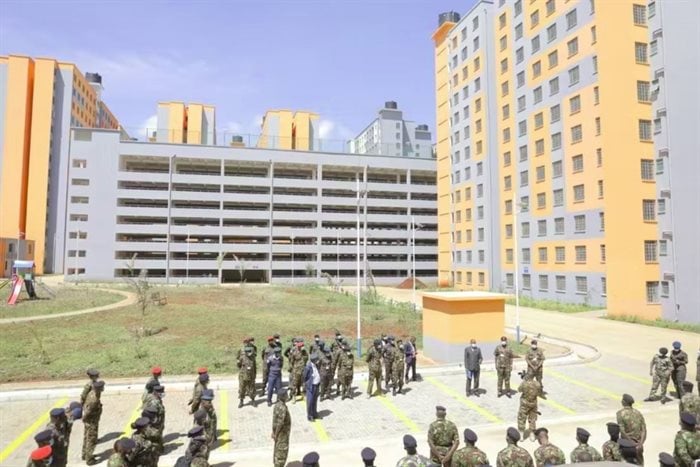Kenya's push for affordable housing is creating opportunities despite barriers

At the start of his second term in 2018, Kenya’s President Uhuru Kenyatta launched an affordable housing programme as one of the big four agenda pillars to promote long-term economic development. The other pillars are food and nutrition security, a robust manufacturing sector and universal healthcare.
Kenya needs to build 250,000 units annually for at least four years to plug its cumulative housing deficit of two million units.
The lowest cost of a new house is estimated at $11,000 (KSh1.1m), and only about 11% of Kenyans earn enough to support a mortgage. Public and private housing developers have previously concentrated on the middle and high-income groups.
Little attention has been given to producing affordable housing to the poor segments of the population, who form the bulk of Kenyan society – 53% by the end of 2020. As a result, over 60% of urban households in Kenya live in slums where they struggle to raise $10 a month for rent.
The government pledged to build 500,000 housing units for the lower and middle-income population segments by 2022. The units were to be sold at a price range of $6,000 to $30,000. But by the end of 2021, the five-year plan had yielded only 431 units or 0.8% of the target.
Our study examined the current status of the affordable housing strategy, aiming to identify the opportunities it presents and what’s hindering progress.
We looked at the first project in the programme, in Nairobi’s Ngara Estate, which has so far delivered 228 affordable units. It has created extensive opportunities for investment in construction, and the manufacture and supply of building materials and components. But it faces various challenges which will have to be overcome if the programme as a whole is to succeed.
Demand and supply
Provision of affordable housing remains a problem, not only for developing countries like Kenya, but also many developed countries. The rapid increase in urban population, high cost of construction, finance costs, and escalating prices of urban land are hurdles in Kenya.
In the early and mid-2000s Kenya’s government proposed a raft of tax incentives to stimulate supply and demand for housing.
But demand continued to exceed supply. Only 50,000 housing units were constructed annually in Kenya’s urban centres against the annual need of 250,000. Out of these, only 2% target lower-income families. Affordability problems remain.
Kenya’s affordable housing programme includes:
- The state-controlled Kenya Mortgage Re-Finance Company. Its role is to mobilise cheaper finance from local and international institutions for onward lending by local mortgage providers at 7%, which is half the prevailing commercial rate;
- The National Housing Development Fund to mobilise funds from potential house buyers;
- Tax incentives for housing development and home acquisition.
Slow uptake
The project we studied, Ngara Estate, is being built on nine acres of land at a cost of $50m (KSh5bn). It is being built and financed by the Chinese government. The project includes a nursery school and shopping centre, among other communal facilities. Its 1,370 housing units are to be sold at $10,000 for a one-bedroom, $20,000 for two-bedroom and $30,000 for a three-bedroom house.
Houses are to be allocated by lottery. Kenyans interested in the houses are supposed to register online giving personal details such as employment status, household particulars and preferred area of residence.
The government of Kenya provided land and mortgage facilities to the middle-class buyers of the project.
Based on data obtained from texts, interviews, observation, discussion, media review, and government’s published manuals, we found that uptake of the completed units was slow. This is because most applicants are unable to raise the 12.5% of home value required to participate in the lottery for house allocation.
Opportunities and challenges
The Ngara project has generated 650 direct job opportunities for artisans in the informal sector. Use of locally available resources, labour and artisans in the housing programme could lower costs and employ thousands of Kenyans.
Another finding is that building designs and components can be standardised and prepared offsite, then transported and assembled. This would cut costs and time.
Our study found that innovative and alternative building materials and technologies could also achieve savings. A number of public and private companies producing alternative building materials are in operation in Kenya.
On the other hand, challenges of the programme include:
Funding: Housing and real estate development is a highly capital-intensive venture and funds are in short supply.
Shortage of land for development: The project requires land which is serviced with infrastructure and in good locations. But such land is in short supply in Kenya, and therefore expensive.
Cost of construction: Design, materials and labour make up 50–70% of housing development cost.
Poor physical and social infrastructure: Infrastructure is lacking in many urban centres in Kenya and developers often transfer the costs of infrastructure to end buyers.
Bureaucracy: Many agencies are involved in the approval and licensing of housing development proposals and this makes the process lengthy, costly and complicated. None of the laws and standards in connection with building construction directly addresses development of mass affordable housing.
Resettlement: People are being moved to make way for affordable housing projects.
What should be done
- Developers, contractors and other players in the housing industry should harness the opportunities available for mass housing development.
- The government and professionals in the built environment sector should educate the public about the benefits of alternative materials and technologies.
- The state should open up more land for affordable housing.
- The National Housing Development Fund should consider more sources of finance, such as the capital market.
- A policy framework is needed to guide design, size of units, location and long-term maintenance.
- More public participation and consultations should be conducted to avoid resistance to relocation.
This article is republished from The Conversation under a Creative Commons license. Read the original article.![]()
Source: The Conversation Africa

The Conversation Africa is an independent source of news and views from the academic and research community. Its aim is to promote better understanding of current affairs and complex issues, and allow for a better quality of public discourse and conversation.
Go to: https://theconversation.com/africa






















